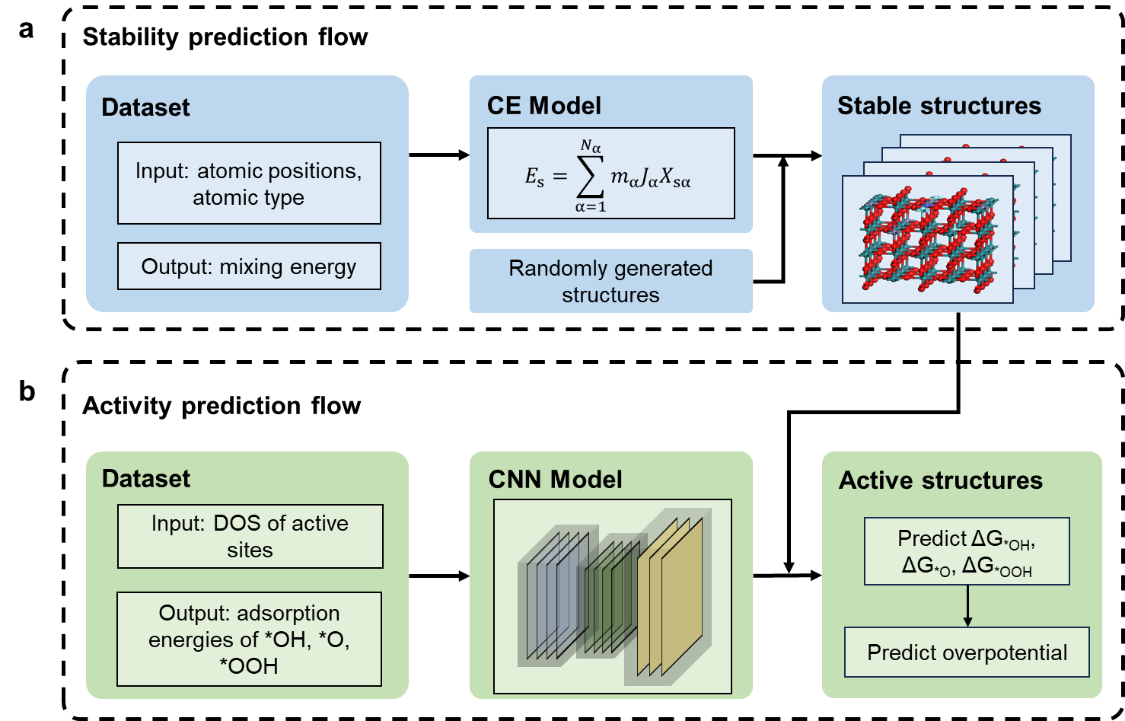RuO2-based catalysts have shown great potential in acidic oxygen evolution reaction (OER) due to their lower price and higher activity than the widely used IrO2. However, their large-scale application is seriously limited by the slow OER kinetics and severe degradation of catalysts in acid media. Although tremendous reports have demonstrated that doping other elements to RuO2 is a promising way to improve the catalytic stability and activity of RuO2-based catalysts, the lack of effective screening strategy makes the elaborate search to extensive doping space impractical due to high cost of both experimental tests and the first principles calculations. Thus, a more efficient model is urgently required for accurately predicting stability and activity of RuO2-based catalysts and seeking out the doping structures with the optimized stability and activity.

Figure 1. The high-throughput screening flows of (a) catalytic stability based on the cluster expansion (CE) model and (b) catalytic activity based on the convolutional neural network (CNN) model.
Here, we developed a general machine-learning (ML) framework to screen out the doped RuO2 with desired performance (Figure 1), in which the cluster expansion (CE) models based geometric features and convolutional neural networks (CNNs) based on density of states (DOS) were used to evaluate stability and activity of catalysts, respectively. Compared to the traditional d-band theory and some other previous models, our ML model was constructed based on more general input features and realized significantly higher prediction accuracy with mean absolute errors (MAEs) of 0.0033 eV/atom, 0.074, 0.142 and 0.082 eV for mixing energies of substrates, adsorption energies of *OH, *O and *OOH intermediates, respectively (Figure 2). Our calculations indicated that Zn was found to be able to effectively improve the stability of doping structures, and Ti, Mn, Fe, Co, Rh, especially Fe and Co, are ideal choices of active sites for excellent OER activity. By screening doping space, three doped structures of RuO2-based OER catalysts (Ru41Zn7O96, Ru41Zn4Fe3O96 and Ru39Zn4Cu4Co1O96) with both high stability and activity were sought. The high stability and activity were further validated by both DFT and experiments, as shown in Figure 3.

Figure 2. (a) The prediction performance of the CE model on mixing energy. The prediction performance of the CNN models on (b) ΔG*OH, (c) ΔG*OOH, (d) ΔG*O.
In summary, this work provided an ML paradigm in fields of material screening and a useful guide for experimental synthesis.
Figure 3. (a) Free energy profile for AEM path on the surfaces of RuO2, Ru41Zn7O96, Ru41Fe3Zn4O96, andRu39Co1Cu4Zn4O9. (b) Calculated ΔG values for surface Ru atoms in RuO2 and three screened catalysts dissolution into RuO4 in acid solvents. (c) Chronopotentiometry stability test of the Co, Cu, Zn-doped RuO2, home-made RuO2, and C-RuO2 at a constant current density of 10 mA cm−2.
This work titled “A General Machine-Learning Framework for High-Throughput Screening for Stable and Efficient RuO2-Bsed Acidic Oxygen Evolution Reaction Catalysts” has been published in ACS Catalysis, the first author and the corresponding author are respectively Zhe Shang and Hui Li from Beijing Advanced Innovation Center for Soft Matter Science and Engineering, Beijing University of Chemical Technology, Beijing100029, China. This work is supported by the National Key R&D Program of China and the National Natural Science Foundation of China. The DOI for this work is 10.1021/acscatal.5c02247.